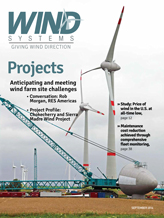Once the wind has been converted to mechanical rotating energy and then to electrical energy, it leaves the turbine.
For some of us, our job is over. Some technicians don’t work on anything beyond the turbine. For others, their responsibilities continue — or have just started — with still many components and miles of conductors to maintain. This part of the wind farm is called the “collector system,” and without it, the wind farm doesn’t work.
The collector system is comprised of many components. An important component of this system is the transformer. A transformer is an electrical component that has the ability to change high current, low voltage into high voltage, low current.
Transformers are used everywhere in the wind turbine and what is discussed here for the power transformers is applicable elsewhere. Transformers are electrical components that only work in alternating current (AC) systems.
The transformer takes the relatively low-voltage, high current power from wind turbines and “transforms” it to high-voltage, relatively low current for transmission over long distances. Or, when the turbine is not producing, the transformer takes the high-voltage low current and transforms it into low-voltage, relatively higher current for the turbine to operate its various systems.
In a transformer, the relationship between voltage and current are inversely proportionate. For example, if voltage is increased by a factor of 10, the current is reduced by a factor of 10. It is important to reduce the current for transmitting the energy for distance to reduce power or line loss. Line loss can happen just like when you try to use more than one long extension cord to run a power tool. There are voltage drops due to the friction of the electrical current in the conductor. On long distance power lines, if the voltage gets too low, then the voltage can be stepped up again by using another transformer.
Maintaining these transformers is fairly easy. For pad-mount transformers, keep your services trucks from running into them and if you are in areas of ice, build protective shelters to keep falling ice from damaging them. Keep the doors closed, seal the conductor entries to keep out the rats, and regularly inspect for bad connections — safely.
Checking for oil leaks and proper oil levels, as well as taking samples of the transformer oil can tell you if there are signs of internal problems. Hydrogen and acetylene are some of the gases found in the oil of transformers that are considered indicators of problems.
The concentration threshold of these gases is up to interpretation of an experienced transformer engineer. Some of today’s transformers have high hydrogen gas counts, but when the transformer is inspected, there is no visible problem found. This is thought to be caused by certain manufacturing techniques beyond the scope of this article.
When transformers go bad, they can go quiet, or they can go out with a bang. A transformer explosion is extremely powerful and can cause significant damage. Transformer explosions can be so powerful that some wind farm substations utilize special concrete blast walls to separate transformers from other components in the substation for protection.
In the collector system, when the electrical current leaves the transformer, it continues to flow through high voltage conductors. Sometimes the conductors are underground and sometimes they are above ground, or a mix of the two. Both types have their advantages and disadvantages.
For underground systems, the advantage is that there are no cables to look at so a better visual view. A disadvantage is the cable is fairly expensive due to the insulation required to place the cable underground. Underground cable is connected together with specialty connectors. These connectors are typically called splices, and consist of conductor and insulator. It is just as important to properly treat the insulator as it is to connecting the conductor. High voltage electricity can destroy a high voltage electrical splice even if the conductor is well prepared but the insulation of the splice has not been prepared properly or treated well. Just a small nick in the insulation at the splice can cause a early failure.
With above ground or overhead conductors we typically don’t have the same issue with insulation as air is used but issues with the power poles and animals can cause problems. Birds can build nest or cross conductors if the lines are not properly designed. The conductor lines can swing in the strong winds and short between another. In addition, in an effort to save money during construction, we sometimes have power poles that are not properly sized or not spaced properly and become overloaded with weight and line tension causing all kinds of havoc with leaning or bent poles and overloaded pole to line insulator connections.
These high voltage collector circuits, whether underground or overhead, feed power from the individual wind turbines and consolidate the power at a substation. At the substation the power is consolidated and usually transformed once again to a higher voltage and then sent out to the grid. In the substation, there are a variety of protection devices that use current, voltage, thermal and magnetic sensors to ensure things are safe. In addition, there is lightning protection and a substantial grounding system. There are circuit breakers and switches to control the power flow. Monitoring systems watch the power flow and the grid operator typically has control to operate or disengage the substation if something is awry.
Hopefully this article has served as an introduction to the collector system, and raises some curiosity and discussion with your team. It is beneficial that everyone understands the specifics of the collector system used by your facility.
As always work as safely as possible, and work to prevent surprises.





























